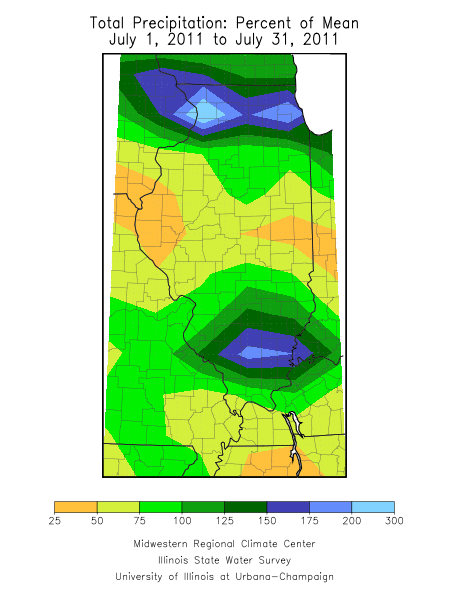July was one of the hottest and driest on record. So was the year to date. Here are how things stack up so far.
How July Ranks
This July was the second warmest and fourth driest on record in Illinois, based on preliminary numbers for the month. The statewide average temperature was 81.8 degrees, 6.4 degrees above normal (1981-2010 average). The statewide average precipitation was 1.47 inches, 2.58 inches below normal or 36 percent of normal.
Statewide Average Temperature Rankings for July in Illinois
- 1936: 83.1 ºF
- 2012: 81.8 ºF
- 1901: 81.7 ºF
- 1934: 81.3 ºF
- 1916: 80.4 ºF
Statewide Average Rainfall Rankings for July in Illinois
- 1930: 1.02 inches
- 1916: 1.23 inches
- 1936: 1.24 inches
- 2012: 1.47 inches
- 1914: 1.51 inches
I think July 1936 still wins the prize as the most miserable month in Illinois records with the hottest temperatures and the third driest rainfall total. I’m sure 1916 was no fun either as the fifth warmest and second driest July on record. Of course, air-conditioning was pretty much non-existent in 1936. My dad says he remembers sleeping outside that July on the family farm in western Illinois (near Nebo) because the house was too hot.
How the Year-to-Date Ranks
This year so far is the warmest and third driest on record. The statewide average temperature for January-July 2012 was 56.9 degrees, 5.5 degrees above normal. The statewide average precipitation for January-July was 14.05 inches, 9.82 inches below normal or 59 percent of normal.
Statewide Average Temperature Rankings for January-July
- 2012: 56.9 ºF
- 1921: 56.1 ºF
- 1987: 54.1 ºF
- 1998: 54.0 ºF
- 2006: 53.9 ºF
Statewide Average Precipitation Rankings for January-July
- 1936: 12.22 inches
- 1934: 13.55 inches
- 2012: 14.05 inches
- 1988: 14.60 inches
- 1914: 15.20 inches
Rainfall Map
This rainfall map was generated by our GIS specialist Zoe and uses NWS radar and rain gauge data. The result is a more detailed picture of the rainfall in July 2012. A few lucky areas in northeastern and far southern Illinois received 2 to 4 inches of rain. Most of the state got an inch or less.





